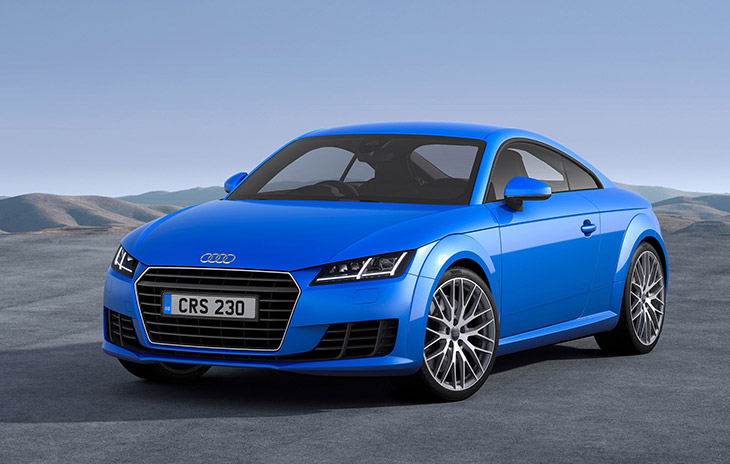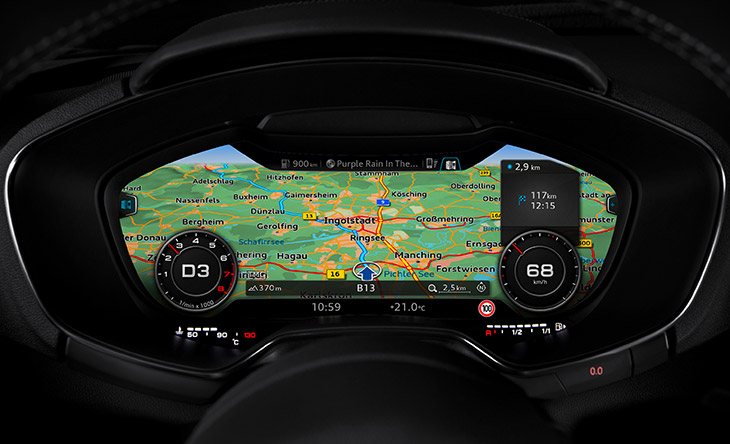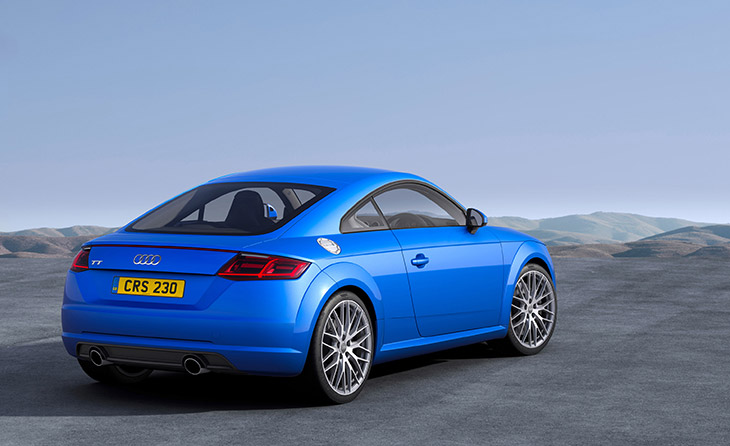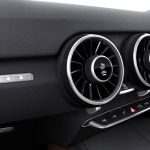 Automotive supercomputer meets state-of-the-art sports car in the all-new Audi TT, which is available to order in the UK from today priced from £29,770 OTR ahead of first deliveries in December. Enveloping its stunning all-digital virtual cockpit and advanced new chassis in a beautiful new body that is unmistakably TT but also distinctly contemporary, the third generation car looks set to incite another quiet revolution in its class. It will even set the agenda in terms of efficiency – despite appropriate performance the new 184PS ultra version will be capable of in excess of 67mpg with CO2 emissions of just 110g/km.
Automotive supercomputer meets state-of-the-art sports car in the all-new Audi TT, which is available to order in the UK from today priced from £29,770 OTR ahead of first deliveries in December. Enveloping its stunning all-digital virtual cockpit and advanced new chassis in a beautiful new body that is unmistakably TT but also distinctly contemporary, the third generation car looks set to incite another quiet revolution in its class. It will even set the agenda in terms of efficiency – despite appropriate performance the new 184PS ultra version will be capable of in excess of 67mpg with CO2 emissions of just 110g/km.
Two specification levels – Sport and S line – will initially be offered in the UK for the all-new TT. Both include the Audi virtual cockpit, which is based around a 12.3-inch, high resolution LCD display that completely fills the driver’s instrument binnacle and replaces the traditional analogue dials. Its brilliantly sharp images are courtesy of a powerful Tegra 30 graphics processor from Nvidia’s Tegra 3 series.
Drivers can choose between two display modes: In the classic view, the speedometer and rev counter are in the foreground; in “infotainment” mode the virtual instruments are smaller. The space that becomes free as a result provides ample room for other functions, such as the navigation map. At the lower edge of the Audi virtual cockpit, the displays for outside temperature, time and mileage are permanently visible. Warning or information symbols are also displayed there.
Interior technology highlights from the equipment list for Sport models also include the Multi Media Interface with the MMI touch pad for fingertip data entry, navigation preparation, Audi Music Interface and Bluetooth connectivity, the Audi drive select adaptive dynamics system and keyless go. Complementary comforts also include Alcantara and leather combination upholstery for the standard sports seats and manual air conditioning with controls integrated into the air vents in another break with convention. Outside the cabin, 18-inch 10-spoke alloy wheels, sports suspension, xenon headlamps with LED daytime running lights and a speed-dependent active rear spoiler all also feature as standard.
LED headlights as standard for S line
S line specification is the most comprehensive and the most performance-oriented in the initial TT line-up. It adds larger 19-inch alloy wheels with a five-arm star design, all-weather LED headlights and LED tail lights flanked by dynamic rear indicators with a directional sweeping function and S line body styling. It also offers particularly committed drivers the no cost option to swap to tauter S line sports suspension bringing a further 10mm reduction in ride height.
From the options list, even more of the remarkable Audi virtual cockpit’s potential can be unlocked by the Technology Package, which includes hard disk-based navigation mapping that can completely fill the 12.3-inch TFT monitor, and also beams the Internet to the car via Audi connect.
This brings features such as Google Maps, Google Street View, Audi traffic information online, price-graded refuelling locations in the vicinity and the latest news, flight and train information to streamline every journey. It also adds Audi music stream and access to social media services such as Facebook and Twitter. For sound that is as attention-grabbing as the cabin’s visuals, a 680-watt, twelve-speaker Bang & Olufsen audio system can be specified in addition.

On the outside, the range of nine paint colour options for Sport models includes two shades that are new to the Audi range – Tango Red and Nano Grey. The list of available colours for S line versions includes one extra choice – Daytona Grey. Another highlight exterior option is matrix LED headlights, each of which features 12 separate LED bulbs which dim individually when sensors detect oncoming or following traffic to automatically divert light around obstacles without the need to deactivate the high beam setting.
A sports car for everyday use
At 4.18 metres long, the Coupé is almost exactly the same length as its predecessor, though its wheelbase has grown by 37 mm to 2,505 mm, making for especially short overhangs. It is 1,832 mm wide, and has the same height as the previous model at 1,353 mm. As a 2+2 seater, it is a sports car that is suitable for everyday use, with a load area capacity of 305 litres – 13 litres more than before – which can be increased to 712 litres by folding the rear seat backrests forwards.
The remarkable blend of performance and economy offered across the TT range is partly attributable to its advanced Audi Space Frame composite construction, which has been carried over and further evolved for the all-new model. Blending steel with a high proportion of lightweight aluminium in areas such as the side sills and side sections, roof, bonnet, doors and hatch lid has helped the 2.0-litre TFSI model to tip the scales at an impressive 1,230kg – 50kg less than its equivalent predecessor.
The 2.0 TFSI – one of two engine options available at launch – is suitably technologically advanced in keeping with its new habitat. The EU6-compliant four-cylinder unit combines direct and indirect fuel injection for optimal combustion, the Audi valvelift system (AVS) for precise valve stroke control on the exhaust side and thermal management, which uses a rotary valve module and an exhaust manifold integrated into the cylinder head.
In the TT the high-tech unit is combined with either front-wheel-drive and a six-speed manual gearbox or quattro all-wheel-drive and a six-speed S tronic twin-clutch transmission. Developing peak torque of 370 Nm from 1,600 to 4,300 rpm, it powers the front-wheel-driven version from 0 to 62mph in 6.0 seconds, and on up to a top speed of 155mph. Combined economy is a creditable 47.9mpg, delivered with CO2 output of 137g/km.
S tronic with freewheeling function
In the version with six-speed S tronic transmission and quattro all-wheel drive, performance is even more brisk: the sprint from 0 to 62mph takes 5.3 seconds; top speed is 155mph; in this version combined economy tops out at 44.1mpg with CO2 emissions of 149 g per km. The dual-clutch transmission shifts through the six gears without any noticeable interruption in traction, and in manual mode it can be controlled by paddles on the steering wheel. When the Audi drive select system is set to its ‘efficiency’ mode, the S tronic transmission decouples and ‘freewheels’ each time the driver takes his or her foot off the throttle pedal.
The second engine option – the 2.0 TDI – powers the exclusively front-wheel-driven and six-speed manual-equipped ultra model. It features two balancer shafts in the crankcase, adjustable camshafts and a common rail injection system delivering maximum pressure of 2,000 bar.
Audi engineers never lost sight of the fact that the overtly efficiency focused TT ultra is first and foremost a sports car, and helped by a strong torque peak of 380 Nm it proves the point by accelerating from 0 to 62mph in 7.1 seconds and reaching a top speed of 150mph. Equally importantly it can also return up to 67.3mpg according to the combined cycle test, which translates into CO2 emissions of 110 g/km, a new record low level in the sports car world.
The chassis also reflects the technological expertise behind the new Audi TT. The front suspension is based on a MacPherson system, and integrates aluminium components which reduce the weight of the unsprung chassis masses. The four-link rear suspension can process the longitudinal and transverse forces separately.
A progressive steering system is another technical highlight and is fitted as standard to all versions – its rack is set up in such a way that the ratio becomes more direct as the steering wheel is turned, enabling the TT to be steered precisely with little movement of the steering wheel in urban traffic and on winding country roads. The highly efficient, electromechanically driven steering adapts its assistance to speed and forms the basis for the Audi active lane assist system which is standard for the TT 2.0 TFSI, and for the various park assist options.

Customisation of settings
The degree of steering assistance is one of the elements that can be controlled via the standard Audi drive select adaptive driving system. Offering Comfort, Dynamic, Efficiency, Individual and Auto modes, Audi drive select can also influence the operating parameters of the engine, the S tronic transmission and, when Efficiency mode is selected, the operation of the air conditioning and start-stop system.
In time-honoured fashion, quattro permanent all-wheel drive delivers additional high speed composure and traction in the new Audi TT, but the multi-plate clutch-based system has evolved alongside the iconic sports car. A newly designed hydraulic pump reduces weight by around 1.5 kg compared with the previous model, and the software that determines the level of torque distribution between the front and rear axles in a split second has been completely redeveloped. The innovative control system continuously senses the ambient conditions, driving status and the driver’s wishes and adjusts torque distribution accordingly in real time.
Networking quattro drive with the standard Audi drive select system has given the driver greater control over the operating parameters of the all-wheel-drive system. In “auto” mode, optimum traction and balanced driving dynamics are given priority. In “dynamic” mode, torque is distributed to the rear axle earlier and to a higher degree. And in another new departure for the new TT, when the “efficiency” mode is selected the system can precisely determine driving conditions and driver type and can temporarily shut down the quattro system if conditions suit this. In this operating state, the intelligent software carefully monitors the driving situation and can reactivate all-wheel drive as soon as it is required again.
Electronic stabilisation control (ESC) stands guard in all versions, but the advanced system can also be switched off either partly or completely. When negotiating bends, it redistributes torque from the inside front wheel to the outside front wheel (front-wheel drive) or, on quattro models, to the rear wheels, if required. Thanks to the difference in propulsive forces, turn-in to corners is very easy, which is helpful for the driver. In this way, bends can be navigated with great precision and neutrality. ESC also offers a Sport mode which supports more committed driving, facilitating steering and control at high speeds.
Speed modulation is very effectively taken care of by disc brakes, which are ventilated at the front and have a diameter of up to 338 mm depending on model. A button-operated electromechanical parking brake acting on the rear wheels is another new TT feature which is standard across the board.
A portfolio of driver assistance options
To minimise stress in everyday driving, a portfolio of advanced electronic aids is also available for the new TT. Audi side assist uses rear-mounted radar sensors to help drivers change lane more safely; camera-based traffic sign recognition can alert the driver to speed limits even when they have been temporarily imposed; the park assist system with display of surroundings independently guides the car into suitable spaces; and the Audi pre sense basic safety system takes protective action such as closing the windows and tensioning the seatbelts if sensors detect an impending collision.
Last but not least, Audi active lane assist helps the driver if required by steadily correcting steering or warning if there is a danger of unintentionally drifting out of lane – this feature is standard for the 2.0 TFSI model and optional for the 2.0 TDI ultra.
Picture caption
TT makes a sporting comeback – The all-new Audi TT Coupe opens for order in the UK this week priced from £29,770 OTR. The Sport and S line models powered by 184PS and 230PS TDI and TFSI engines are the first to feature an all-digital Audi virtual cockpit.
2014 Audi TT UK
Source: Audi









